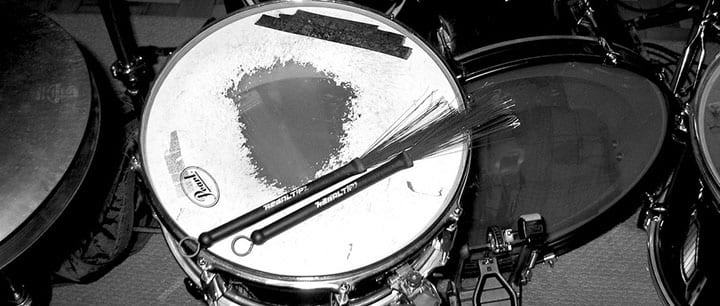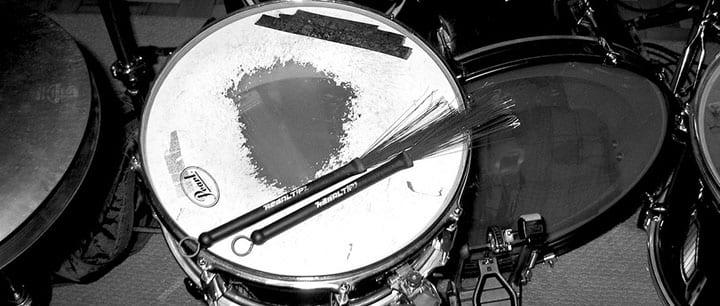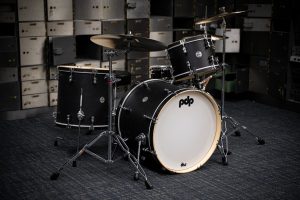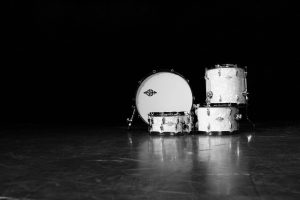 Drum tabs are an abbreviated, simple form of musical instruction used in place of traditional sheet music for drummers. Many modern musicians and music students prefer to use this kind of tablature because it’s easier to write and easier to find. Instead of looking for sheet music in the music store, for example, you can simply go online and find thousands of drum tabs for all your favorite songs.
Drum tabs are an abbreviated, simple form of musical instruction used in place of traditional sheet music for drummers. Many modern musicians and music students prefer to use this kind of tablature because it’s easier to write and easier to find. Instead of looking for sheet music in the music store, for example, you can simply go online and find thousands of drum tabs for all your favorite songs.
In this post, we will tell you everything you need to know about drum tabs – how to read them, how to write them, and a few examples of drum tab notation to get you started!
Are There Tabs for Drums?
When you’re trying to figure out how to read drum tabs and play the drums, the first question to answer is what drum tabs actually are – and if there are tabs for drums. This is an important part of learning music theory, but rest assured, there are drum tabs! They just look a bit different than other types of sheet music.
For cymbals, examples might include:
- |-x-| Strike cymbal or hi-hat
- |-o-| Open hi-hat
- |-#-| Choke cymbal (grab cymbal with hand after striking it)
- |-c-| China cymbal
- |-x-| Click hi-hat with foot
While for other types of drums, you might see the following drum tab notation:
- |-g-| Ghost note
- |-d-| Drag
- |-b-| Soft one-handed roll
- |-@-| Snare rim
Drum tablature, also known as drum tabs or drum tab, is just a form of simplified notation or sheet music for percussion instruments. Instead of notes that you might find on sheet music for other types of drums, drum tabs have symbols that represent how and when you should strike the instrument.
Tabs are much easier for percussionists to use than other kinds of sheet music because they are easier to write, easier to type, and easier to share over the Internet. Sheet music takes special music notation software to write while anybody can write drum tab notation.
How Do You Read Drum Tabs? 6 Tips
Tabs are different from sheet music because they are written specifically for the instrument, rather than the sound. Sheet music is written with musical notes, while tabs are written with letters and various markings. Want to learn to play the drums? Understanding drum tabs is going to be a key part of that adventure!
Here are a few tips to help you learn how to read drum tabs quickly – don’t stop that beat!
1. Get Used to the Kit
You’re going to have a hard time reading and playing drum tabs if you don’t know and understand the different types of drums in the kit. In drum tabs, each drum will be represented by a different abbreviation, but these can vary depending on the writer.
Make sure you look for some sort of legend so you know you are understanding the writer’s notation system correctly. Some common pieces and abbreviations include:
- B – Bass Drum
- CC – Crash Cymbal
- FT – Floor Tom
- Hf – Hi Hat with Foot
- HH – Hi-Hat
- Rd – Ride Cymbal
- SN – Snare
- T1 – Hi Tom
- T2 – Low Tom
Typically, the drums are listed in order of height, from shortest to tallest.
2. Know Your Symbols
Next, familiarize yourself with the symbols. There are five main ones for hitting drums in addition to a few central ones for cymbals specifically.
For drums, they are:
- d = double stroke or a roll
- f = flam or two strokes hit by alternating hands
- g = ghost or hit softer than normal
- O = accent or hit harder than normal
Here’s a quick video with drum rudiments that you might see in drum tabs:
And for cymbals, they look like:
- # = choke or hit the cymbal, then grab it
- X = hit hard cymbal or loose hi-hat
- o = hit open hi-hat
- x = strike
There is also a symbol that is simply a dash (-) that can be used for either cymbals or drums and is meant to tell you not to hit the instrument on a certain beat.
3. Watch the Rhythm
One of the most challenging aspects of reading drum tabs and playing drums, in general, is knowing how to stick to a rhythm. Most music is written in 4/4 time with a beat divided into 8 or 16 counts, but that’s not always the case.
Counting clearly and consistently will help you get the hang of playing each beat when you need to but keep an eye out for any variations in the rhythm.
4. Look at Repeated Bars
Repeated bars are usually notated above the rest of the information about the tab and are indicated by something like “repeat x 5,” which would indicate that the tab needs to be repeated 5 times before moving to the next bar. This is simply shorthand to make writing tabs a bit easier and is an advantage over drum sheet music.
5. Don’t Ignore the Legend
The legend on the drum tabs will include lots of helpful information that you need to know about a set of drum tabs, like what sorts of instruments the tabs are for, what dynamics to include, and more.
6. Start Small
Getting the hang of reading drum tabs can be tricky, but we recommend starting with just one instrument. Once you become skilled with one kind of instrument, like the snare drum, you can add in others – until you’ve mastered eight or nine!
Get comfortable with a few lines of music and then progress to the rest. If you try to take on a whole set of tabs at once, you’re probably going to become stressed and overwhelmed. Just do a little at a time!
How Are Drum Tabs Written?
The nine parts of the drum kit are written in the order listed above on each drum tab, from top to bottom; the musical instructions are written from left to right. For example:
HH x-x-x-x-x-x-x-x-
SN -o- -o- -o- -o- -o
B -x- -x- -x- -x- -x–
The preceding tablature shows you that three parts of the drum kit are being used in this piece of music: the hi hat, the snare drum, and the bass drum. Furthermore, it shows you when to play each piece during a musical count of 16 beats. Look closely, and you’ll see that each line of rhythm for each component has 16 marks per line, so 16 beats. The dashes (-) tell you not to strike the instrument during this particular beat, while any other symbol (x,o) tells you to hit it. A music teacher can help you better understand keeping rhythm, but first, it’s important to practice playing more than one piece of the drum kit simultaneously, as in the tablature.
Reminder – Symbols Used in Drum Tablature
Full drum tabs follow this format for several sets, depending on how long the piece of music is. The different symbols on a line, such as o, x, X, #, or b, tell you how to hit a particular part of the drum kit. The “o” means open, the small x means normal and the big X means harder or looser.
Drum Tabs How to Read: Sample Drum Tabs to Explore
If you want to know how to read drum tabs, starting with a few examples of popular songs is a great place to start.
Here are some free drum tabs to help you out. Try the drum tab reading tips we mentioned above to get off on the right foot!
Have fun!
Drum Tabs Explained
If you want to learn how to read all the little intricate details of drum tabs and play them successfully, it’s best to pair up with a music teacher. The right teacher can help clarify instructions that are confusing and give you exercises to work on, which will build up your confidence and skills.
Take a look through the professional drum teachers at TakeLessons and see who fits the bill! Working with a professional who knows what they are doing will get you drumming much quicker.
Photo by Christopher Sessums
Suzy S.






